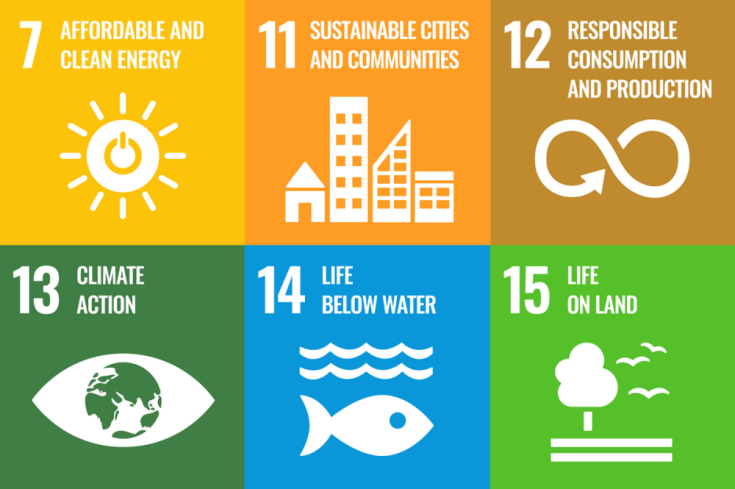Media have an important role to play in galvanising climate action and promoting sustainability, one of the most challenging aspects of the 2030 Agenda. As the Global Week to #Act4SDGs slowly draws to a close, here’s an excerps from our brief “The role of media: Driving change towards the SDGs” focused on the relationship between media and the environmental goals covered under SDGs (SDG 7: Affordable and Clean Energy, SDG 11: Sustainable Cities and Communities, SDG 12: Responsible Consumption and Production, SDG 13: Climate Action, SDG 14: Life Below Water, SDG 15: Life on Land)
“For people to seize the opportunities and reduce the risks (…) everyone will need to know more about climate change. The way the media covers it will affect how well societies deal with the problem. (…) Three of the media’s traditional roles — informing audiences, acting as watchdogs and campaigning on social issues — are especially relevant”
– UNESCO[i]
As a source of information, media play a major role in communicating climate science. They can increase public awareness about climate crisis[ii] and affect environmental attitudes and behaviours[iii], from plastic avoidance[iv] to waste recycling[v]. For example, the framing and intensity of coverage exerts an important influence over risk perception and support for policies that address the climate emergency[vi]. In particular, environmental and advocacy journalism have an important role to play in driving the transformative shifts necessary to avoid catastrophic man-made climate effects[vii].
Press freedom goes hand in hand with a higher level of environmental performance.[viii] Media help to intensify the issue’s salience and create public pressure for change, thus shaping policy responses and mitigation strategies[ix] and corporate environmental practices[x]. Additionally, media are among the leading actors involved in disaster management[xi], a role that is increasingly crucial in the face of accelerating climate catastrophe and the increased occurrence and intensity of extreme events.
Below we present case studies of impactful journalism and information sharing done by MDIF clients done in the area of SGD 7, 11, 12, 13, 14 and 15 as real-world examples that illustrate the transformative power of media.
Example of impact
In Guatemala, national newspaper elPeriódico revealed a major fraud and corruption scheme related to the clean-up of pollution at Lake Amatitlán. When in office, Vice-President Roxana Baldetti awarded a contract worth millions of dollars to an engineering firm to decontaminate the lake. ElPeriódico published an article revealing the terms of the contract that had been kept secret and showed that the company would use a cleaning chemical – a solution of water, salt and chlorine – that was ineffective. The Vice-President was put on trial on fraud and influence-peddling charges. A court sentenced her to 15 years and six months in jail for her role in what became known as the “Magic Water” scandal.
In Serbia, there has been an increase in small-scale hydro projects, which the coal-reliant country has encouraged in order to try to meet ambitious renewables targets as part of efforts to join the European Union. Howewver, locals fear that the plants will devastate fish stocks, cause wells to dry up and deprive livestock of water. Serbian news outlet, Nova Ekonomija was the first to expose the potential ecological damage from the introduction of mini-hydro plants on the Studencia river in southwestern Serbia. Shortly after this information was published, the President of Serbia announced the cessation of these projects on the river.
Read the full brief “The role of media: Driving change towards the SDGs” here.
[i] UNESCO (2022) “Getting the Message Across. Reporting on Climate Change and Sustainable Development in Asia and the Pacific: A Handbook for Journalists.”
[ii] Arlt, D., Hoppe, I., and Wolling, J (2011). “Climate change and media usage: Effects on problem awareness and behavioural intentions”. International Communication Gazette.
[iii] Holbert, R. L. Kwak, K. Shah, D.V (2008). “Environmental Concern, Patterns of Television Viewing, and Pro-Environmental Behaviors: Integrating Models of Media Consumption and Effects” Journal of Broadcasting & Electronic Media; Dahlstrom, M.F, Scheufele, D. A (2010). “Diversity of Television Exposure and its Association with the Cultivation of Concern for Environmental Risks.” Environmental Communication; Huang, H. (2016). Media use, environmental beliefs, self-efficacy, and pro-environmental behavior.” Journal of Business Research
[iv] Borg, K. (2021). “Media and social norms: Exploring the relationship between media and plastic avoidance social norms”. Environmental Communication.
[v] Chan, K (1998). “Mass Communication and Pro-Environmental Behaviour Waste Recycling in Hong Kong”. Journal of environmental management.
[vi] Swain, K.A (2016). “Mass Media Roles in Climate Change Mitigation”. Springer; Sampei, Y. Aoyagi-Usui, M (2009). “Mass-media coverage, its influence on public awareness of climate-change issues, and implications for Japan’s national campaign to reduce greenhouse gas emissions”. Global environmental change; Carmichael, J. Brulle, R (2016). “Elite cues, media coverage, and public concern: an integrated path analysis of public opinion on climate change, 2001–2013”. Environmental Politics; Hart, P.S (2011). “One or many? the influence of episodic and thematic climate change frames on policy preferences and individual behavior change”. Science Communication.
[vii] Salvesen, I. (2018) “Should journalists campaign on climate change? What happened when journalists in a global media organization turned climate change activists”
[viii] Ollerton, J. Walsh, M. Sullivan, T (2019). “Press freedom and environmental protection.”
[ix] Entwistle, T. Enticott, G (2007). “Who or what sets the agenda? The case of rural issues in England’s Local Public Service Agreements.”; Ian Bailey (2002). “Media coverage, attention cycles and the governance of plastics pollution”. Policy Studies.
[x] Su, W., Guo, C., & Song, X (2021). “Media coverage, Environment Protection Law and environmental research and development: evidence from the Chinese-listed firms”. Development and Sustainability; Chen, Z., Jin, J., & Li, M (2022). “Does media coverage influence firm green innovation? The moderating role of regional environment”. Technology in Society.
[xi] Nair, P (2013). “Role of Media in Disaster Management”. Mass Communicator; Rattien, S (1990). “The role of the media in hazard mitigation and disaster management”. Disasters; Garai, J (2017). “Mass Media and Climate Change Induced Disaster Risk Reduction and Mitigation in Coastal Area of Bangladesh: A Sociological Study”. Handbook of Climate Change Communication.
